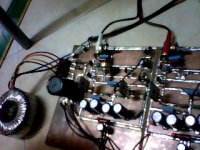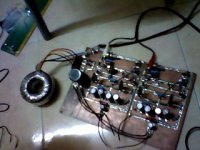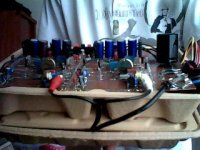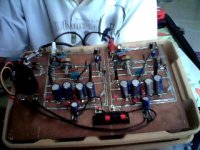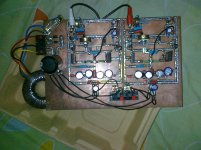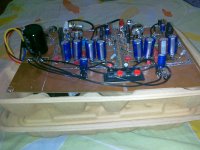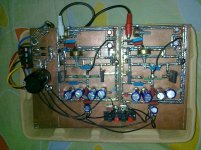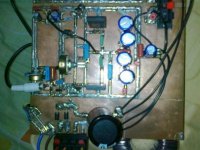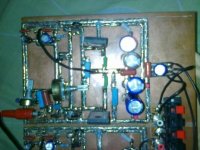yeah, i done my amplifier, uncle , thanks alot for your help !
(although i only finish one side, and accidentally blown my fuse)
although i miss something before, but i manage to fix it back after few diagnosis ! nice sounds of this amp came out ! going to test it with good excellent weekend X.x
haha, going to complete the another one channel today ! .... the amp is excellent for me ! (better than the one i previously brought. The old speaker even sounds better with this amp, compare to the new modern speaker.
(although i only finish one side, and accidentally blown my fuse)
although i miss something before, but i manage to fix it back after few diagnosis ! nice sounds of this amp came out ! going to test it with good excellent weekend X.x
haha, going to complete the another one channel today ! .... the amp is excellent for me ! (better than the one i previously brought. The old speaker even sounds better with this amp, compare to the new modern speaker.
hey uncle ! done both channel !, work and sound nice ! although i haven't adjust the bias and sensitivity X.x (lack of trim-pot) and some output
Going to buy it tmrw and complete your work X.x
My lousy speaker aren't that lousy ! Just that previous amplifier paired with it can't go up power to its level !
Ohh yeah, a occurrence that i dunno how to solve X.x The power supply condenser keep those charges, after i turn of the amplifier Ac supply, the amplifier will still continue playing using contained charges, it dissipate until very low voltage/charges.
Going to buy it tmrw and complete your work X.x
My lousy speaker aren't that lousy ! Just that previous amplifier paired with it can't go up power to its level !
Ohh yeah, a occurrence that i dunno how to solve X.x The power supply condenser keep those charges, after i turn of the amplifier Ac supply, the amplifier will still continue playing using contained charges, it dissipate until very low voltage/charges.
Ahahaha!....so it continues playing...well man...let it be
poor amplifier want to be singing for you...he is in love with you and does not want to be switched off.
regards,
Carlos🙂
poor amplifier want to be singing for you...he is in love with you and does not want to be switched off.
regards,
Carlos🙂
haha, yeah ! I have improve and finish all soldering job ! (left adjusting trim-pot)
I make the output connection of 2, RCA and spring clipper in parallel (use either one at a time only)
you see the wood fiber packaging is my amplifier shelf, which contain spare fuse and the toroidal transformer at the top layer.
Second layer contain all my cable such as power cord, and input connection. (can take out easily whenever i need to use my amplifier)
I make the output connection of 2, RCA and spring clipper in parallel (use either one at a time only)
you see the wood fiber packaging is my amplifier shelf, which contain spare fuse and the toroidal transformer at the top layer.
Second layer contain all my cable such as power cord, and input connection. (can take out easily whenever i need to use my amplifier)
Attachments
Uncle, i dunno its my mistake or circuit's properties, the amp will produce a small static noice when idle (cannot be heard at the range of 0.5m), and a large buzz when the input is leaved open (no connection).
Can you help me to point out what could be the possible error ?
Can you help me to point out what could be the possible error ?
Mr. DX, another question......
how to adjust input sensitivity or gain ? I follow the steps in
how to adjust input sensitivity or gain ? I follow the steps in
But my speaker do not vary the volume when i turn the potentiometer..... I measured the pot with multimeter beforehand, that is works as intended....
Usually this is due to grounding errors... missed ground... well..human mistakes
Also too much high sensitivity (gain resistance too much low..wrong value there).... also supply big mistakes...also potentiometer not shielded, not grounded...well.... i cannot say exactly..... uncle have not developed these super powers to travel to your place, to hold your board in my hands, to inspect and check it.
Go ahead...now it is hard work to find where is the missing ground...the wrong part, the missed connection.
I cannot remember details about this amplifier...watch the thread date and you will see that was some billions of years ago (my memory erasing timing is 1 days or less)..you have the thread.... read it...the gain was for sure informed.
regards,
Carlos
Also too much high sensitivity (gain resistance too much low..wrong value there).... also supply big mistakes...also potentiometer not shielded, not grounded...well.... i cannot say exactly..... uncle have not developed these super powers to travel to your place, to hold your board in my hands, to inspect and check it.
Go ahead...now it is hard work to find where is the missing ground...the wrong part, the missed connection.
I cannot remember details about this amplifier...watch the thread date and you will see that was some billions of years ago (my memory erasing timing is 1 days or less)..you have the thread.... read it...the gain was for sure informed.
regards,
Carlos
Uncle, maybe was my mistake, but i want to make sure.Also too much high sensitivity (gain resistance too much low..wrong value there).... also supply big mistakes...also potentiometer not shielded, not grounded...well.... i cannot say exactly..... uncle have not developed these super powers to travel to your place, to hold your board in my hands, to inspect and check it.
Go ahead...now it is hard work to find where is the missing ground...the wrong part, the missed connection.
I cannot remember details about this amplifier...watch the thread date and you will see that was some billions of years ago (my memory erasing timing is 1 days or less)..you have the thread.... read it...the gain was for sure informed.
regards,
Carlos
Where is the gain resistor in this schematic ? just the numbering with value is enough, thanks in advance !
Attachments
You should read if you have not made that before
In these pages you have the "Trust sensitivity adjustment"
http://users.tpg.com.au/users/gerskine/dxamp/
All pages i have posted, threads and sites, where made in order to save my time and at same time supporting folks with details my memory could not save ... so, there you have the details you may need..this saves me time to do other things and also avoid me to be using my memory (that does not exist at all)
Carlos
In these pages you have the "Trust sensitivity adjustment"
http://users.tpg.com.au/users/gerskine/dxamp/
All pages i have posted, threads and sites, where made in order to save my time and at same time supporting folks with details my memory could not save ... so, there you have the details you may need..this saves me time to do other things and also avoid me to be using my memory (that does not exist at all)
Carlos
Last edited:
hm..... just curious, what was the default gain ? Is there any ideal gain ?
according to my reading at your post, it written the gain resistor was R10 (2k2), but in the schematic, R10 was 2k7, which i thought it was gain resistor, but tweak with no obvious effect on volume
Last edited:
There's no ideal gain... a good idea is not to increase gain too much to avoid
unstabilities and noise pickup.... the gain is the multiplication factor to give you full output swing...some amplifiers needs 1 volt in the input to produce 20 volts.... you see the multiplication factor is 20 ....other amplifier may need only 0.5 volts in the input to produce full voltage swing in the output...in this case the multiplication factor is 40.
There's no magic numbers...it is just basic Arithmetics....of course you can increase value of our words talking about decibels.... well...well.... some loves decibel well well.
Dear Guitar...you seems to be the questions champion of our forum.... i am curious about your name...is it Interrogation Mark (or Mark?)
Carlos
unstabilities and noise pickup.... the gain is the multiplication factor to give you full output swing...some amplifiers needs 1 volt in the input to produce 20 volts.... you see the multiplication factor is 20 ....other amplifier may need only 0.5 volts in the input to produce full voltage swing in the output...in this case the multiplication factor is 40.
There's no magic numbers...it is just basic Arithmetics....of course you can increase value of our words talking about decibels.... well...well.... some loves decibel well well.
Dear Guitar...you seems to be the questions champion of our forum.... i am curious about your name...is it Interrogation Mark (or Mark?)
Carlos
Last edited:
Dear Uncle Carlos,There's no magic numbers...it is just basic Arithmetics....of course you can increase value of our words talking about decibels.... well...well.... some loves decibel well well.
Dear Guitar...you seems to be the questions champion of our forum.... i am curious about your name...is it Interrogation Mark (or Mark?)
Carlos
well.... my name is Leong, you could call me Interrogator Leong
well..... my father was a electrical engineer (now a electrical trader), being bugged by all my question, what can I do ?( its my curiosity to learn these things, and i think its not a wrong, just a bit annoying ?)
hm..... regard about the gain resistor, the resistor you mentioned is referred to "DX Amplifier" hm... your first amp ? never mind about that... which and where could be the gain resistor in DX trust schematic v1.1 ?
well.... i personally love sonic and quality, not too much about decibel nor high gain, but instead i want to make it low gain and nice for my own use, personal listening to music and rhythm to enjoy and relax myself, so i wouldn't want a booming (resulting of high gain and decibel) party going in my house at time of relaxation. Maybe booming if there is really a party, but not now and most of the time "NO"

hm...... i also wanted to build DX precision, but my pocket doesn't have that budget, so later.... too bad
 But i'm happy with DX Trust
But i'm happy with DX Trust And about the adjust bias, it need reading of 5 millivolt, but my multimeter's smallest range was 0.1V ......... any idea to do adjustment ?
Also my output transistor was almost no heat produced can be detected.... (my hand can't feel different between air and transistor, just doesn't felt coldness of those during touching metal) even i don't install heatsink... (just trying😛)
End up only my transformer getting warm (not hot...note that my toroidal transformer have no any mounting nor enclosure)
Is there any other amplifier of yours which cost is similar or cheaper than DX trust ? hope that it will be more "precise" or better in term of quality, not volume X.x
Here is more picture of my dx trust ! Worth to TRUST !
The tray below is container for my toroidal transformer ! the bottom tray is for cable keeping, just a brief keeping shelf.
The tray below is container for my toroidal transformer ! the bottom tray is for cable keeping, just a brief keeping shelf.
Attachments
Ehm ..ehm ..
what about those missing things that are supposed to be between the power Bjts ...aka heatsinks 😕
what about those missing things that are supposed to be between the power Bjts ...aka heatsinks 😕
hm....... i brought those heatsink, but i don't have clip or bolt nut or locking device to hold them on X.x
hm... because the transistor doesn't heat up much (colder then warm water alot... almost the same as ambient temperature), so i thought it can be delayed for later installment...
ARGH........ additional problem now, i only realised now.... the heat sink i have, i don't have same of 4...... so i think this is not acceptable ? (as in differential cooling makes the amplifier act differently ?)
hm... because the transistor doesn't heat up much (colder then warm water alot... almost the same as ambient temperature), so i thought it can be delayed for later installment...
ARGH........ additional problem now, i only realised now.... the heat sink i have, i don't have same of 4...... so i think this is not acceptable ? (as in differential cooling makes the amplifier act differently ?)
Last edited:
If you have an U-shaped aluminium bar that fits , you'll have to drill holes for screwing the transistors on it , after having put a 'washer' in between ( isolator ).
edit : also solid core !!!! but then it has got to be attached firmly (thermically talking ) to a finned one
edit : also solid core !!!! but then it has got to be attached firmly (thermically talking ) to a finned one
- Status
- Not open for further replies.
- Home
- Amplifiers
- Solid State
- Trust, the most delicious Dx Amplifier
